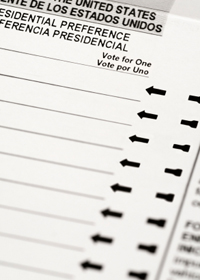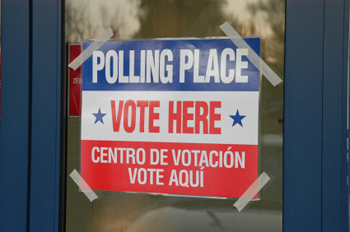
Mathematics and democracy: Approving a president
This article is adapted from the first chapters of Steven Brams' book, Mathematics and Democracy, published by Princeton University Press and reproduced here with kind permission. The book is reviewed in this issue of Plus.
Please note that the AV system discussed in this article ("approval voting") is not the same as the one that was put to the British public in a referendum in May 2011 ("alternative vote").
It may come as a surprise to some that there is a science of elections. It can be traced back to the Marquis de Condorcet in eighteenth century France, Charles Dodgson (better known as Lewis Carroll) in nineteenth century England, and Kenneth Arrow in twentieth century America. Since Arrow published his seminal book, Social choice and individual values, more that fifty years ago — for which in large part he received the Nobel Memorial Prize in Economics in 1972 — there have been thousands of articles and hundreds of books published on everything from the mathematical properties of voting systems to empirical tests of the propensity of different systems to elect centrist candidates.

One person, one vote. US presidential candidates Barack Obama ...
(Photo courtesy Fogster.)
The 2000 US presidential election highlighted, among other things, the frailty of voting machines and the seeming arbitrariness of such venerable US institutions as the Electoral College and the Supreme Court. Political commentary has focused on these aspects but has given very little attention to alternative voting systems, about which the science of elections has much to say.
The system used in the US — and many other places, including the UK — is known as plurality voting (PV). PV is based on the "one person, one vote" principle: every citizen casts only one vote for his or her preferred candidate, and the person with most votes wins. But PV has a dismaying flaw: in any race with more than two candidates, PV may elect the candidate least acceptable to the majority of voters. This frequently happens in a three-way contest, when the majority splits its votes between two centrist candidates, enabling a more extreme candidate to defeat both centrists. PV also forces minor-party candidates into the role of spoilers, as was demonstrated in the 2000 US presidential election with the candidacy of Ralph Nader. Nader received only 2.7% of the popular vote, but this percentage was decisive in an extremely close contest between the two major-party candidates.

... and John McCain.
(Photo by River Bissonnette.)
In this article I make the case for an alternative to PV in multi-candidate elections called approval voting (AV). With AV, voters can vote for, or approve of, as many candidates as they like. Each candidate receives one vote for every voter he or she was approved by, and the candidate with most votes wins. At first sight it may seem strange that voters' preferences, such as who they like most and least on their list of approved candidates, does not play a part in AV. But by seeing AV in action, we'll find that it offers greater flexibility than other voting systems, more sensitivity to voters' preferences, and also has the ability to prevent unpopular results.
Common sense
A few points in favour of AV meet the eye even without a detailed analysis. Under AV, voters can do exactly what they do under PV — vote for a single candidate — but if they have no strong preference for one candidate, they can express this by voting for all candidates they find acceptable. If a voter's preferred candidate has little chance of winning, that voter can also vote for a more viable candidate without worrying about wasting his or her vote. Minority candidates do not suffer from AV since their supporters will not be torn away simply because there is another candidate who, though less appealing to them, is considered a stronger contender. Under AV, they can vote for both.
Today the candidate supported by the strongest minority often wins. Under AV, by contrast, the candidate with the greatest overall support will generally win. AV is likely to cut down on negative campaigning, because candidates will have an incentive to broaden their appeal — not just trash their opponents — in order to gain the approval of supporters of other candidates who are willing to approve of them as well.
Under AV voters are more likely to vote in the first place, because they have greater ability to express their preferences. Also, AV is easy to use and understand. And since it does not violate any state constitutions in the US (or, for that matter, the constitutions of most countries in the world), it requires only an ordinary statute to enact.
What makes a winner?
To understand why the kind of voting system chosen can crucially influence the result, let's look at an example. Suppose we have an election with four candidates, a, b, c and d. The voters split into four groups, with preferences as shown in table 1. Group 1, with 100 voters, prefers a to b, b to c and c to d. Group 2, with 50 voters, favours c over b, b over d, and d over a. Group 3, with 45 voters, has favourite c, ahead of d, followed by b and then a. Group 4, with 10 voters prefers d over b, b over c, and c over a.
| Group 1, 100 voters | a b c d |
| Group 2, 50 voters | c b d a |
| Group 3, 45 voters | c d b a |
| Group 4, 10 voters | d b c a |
Which candidate should win? In plurality voting, where each voter votes only for his or her top choice, a wins with 100 votes, ahead of c with 95 votes and d with 10 votes. The majority is narrow, though, and unlike c, a is ranked last by all but one of the four groups.
Single transferable voting
In an STV election, voters rank the candidates in order of preference. In the first round of counting, only first choices will be looked at. If a single candidate has a majority of votes, then he or she is declared elected. If not, the candidate with the least number of votes is eliminated and his or her votes transferred to the candidates that were ranked second by those who ranked the eliminated candidate first. This process is repeated until a candidate has a majority of votes. If at any stage several candidates stand for elimination because they each received the same low number of votes, then one of several tie-breaking methods can be applied.
As an example, consider the following 3-candidate, 9-voter election, with preferences as follows:
| Group1, 4 voters | a c b |
| Group 2, 2 voters | b c a |
| Group 3, 3 voters | c b a |
Here candidate b is eliminated first, with his or her 2 votes going to candidate c. Candidate c then wins over a by 5 votes to 4.
For an election with just one winner, STV is the same as instant run-off voting. STV can also be used when candidates are competing for more than one seat. In this case, a quota is used to establish when a candidate is declared elected.
Voters' preference might be better represented using a scoring system. To each candidate allocate 3 points for every voter who ranked him or her top, 2 points for every voter who ranked him or her second, 1 point for every voter who ranked him or her third, and 0 points for every voter who ranked him or her last (such a scoring system is known as the Borda count). Borda counts are rarely used in political elections, but they are often used to assess the acceptability of a result. It is now c who wins with 395 points, ahead of b with 365 points, a with 300 points, and d with 170 points.
Single transferable voting (STV), a system which is more sensitive to voters' preferences than PV, does in fact elect c in this example. STV is used in Ireland and several ex-British colonies like Malta; see the box on the right for a description.
Another important idea in election theory is to see how candidates would fare if they were pitted against each other, tournament style, in pairwise contests. When a is pitted against b, then b wins because 105 of the 205 voters prefer b to a. In fact a, the PV winner, loses every single pairwise contest — he is what is called a Condorcet loser. Candidate b, on the other hand, who is nobody's first choice, wins every single pairwise contest, making her the unique Condorcet winner. In general, there might not be a candidate who beats all others in pairwise contests (see the box below), but if there is, one can make a strong argument that any voting system should elect him or her as a winner. In our example, PV, as well as STV and the Borda count, fail to do so.
No Condorcet winner
Consider a 3-voter, 3-candidate election, with the following preferences
| Voter 1 | a b c |
| Voter 2 | b c a |
| Voter 3 | c a b |
In pairwise contests a beats b, b beats c and c beats a, so there is no Condorcet winner.
So how does AV fare in this situation? Perhaps surprisingly, AV can elect any one of the three winners — the PV winner (a), the Borda-count winner (c), and the Condorcet winner (b) — and even d (group 1 votes only for a and all other groups vote for d and candidates they rank above d). Which of these candidates is actually chosen in a given election depends on the voters' strategies. If each voter decides only to approve of his or her first choice, then a wins, as under PV. If all groups approve of their top two candidates, then the Condorcet winner b wins with 160 votes, compared with 100 votes for a, 95 votes for c, and 55 votes for d. If the voters in groups 1, 2 and 4 approve of their top three candidates and those in group 3 of their top two, then the Borda count winner c wins with 205 votes, ahead of b with 160 votes, d with 105 votes, and a with 100 votes.
This might seem strange at first, but it illustrates one of the strengths of AV. For a given election, there are several possible outcomes. Which outcome is actually chosen depends critically on where voters draw the line between acceptable and unacceptable candidates. Where voters draw this line often reflects where the biggest drop-off is in the intensity of their preferences. In my view, this is critical information in the selection of a social choice, but it is absent from most other voting systems.
Acceptability versus preference

Plurality voting in the US presidential elections.
Our example was, of course, carefully chosen and simplified to make this point. But what can we say about AV in a more general setting, wherein there are an unknown number of voters with a plethora of preferences? With some assumptions on voters' behaviour and some logical reasoning, it's possible to show that the flexibility of AV remains intact.
The assumptions are necessary, because no rational analysis can take account of voters behaving irrationally or voting against their own interest. In our case, the assumptions are simple, but not too simplifying: we assume that voters always approve of their favourite candidate and never approve of their least favourite, and that if they approve of a certain candidate a, then they also approve of all the candidates they prefer to a. We also assume that each voter has a strict order of preference, with no two candidates taking equal place.
It's now possible to prove that what we saw in the example above can occur in any election, no matter how many people vote and what their preference profiles are. We can prove that a Condorcet winner, if one exists, will always be one of the possible AV winners. Whether or not the Condorcet winner actually wins the election depends on how many voters choose to put him or her on their approval list. The point is that AV is guaranteed to give the Condorcet winner at least a theoretical chance.
The argument to show that the Condorcet winner is always a possible winning outcome of AV is simple. In an AV election, each voter hands in his or her list of approved candidates, so a candidate is a possible winner of AV if there's a set of approval lists that gives the candidate the most votes. Suppose that candidate c is a Condorcet winner, and suppose that every voter who hasn't ranked c last approves of c but no-one they have ranked below c. Those who have ranked c last may approve of any number of candidates (except c, of course). Now look at any other candidate x. The voters will split into three groups:
- Those who prefer c to x;
- Those who prefer x to c, but didn't put c last;
- Those who put c last.
According to our assumptions, voters in groups 1 and 2 approve of c, while voters in group 3 do not. So we have
Voters in group 1 don't approve of candidate x, those in group 2 definitely do approve of x, and those in group 3 may or may not. So
Now c is the Condorcet winner, so c can beat x in a pairwise contest. This means that more people prefer c to x than prefer x to c. In particular, more people prefer c to x than put c last. Consequently, there are more voters in group 1 than in group 3, so overall candidate c receives more votes than candidate x. This works for any candidate x, so if voters approve of candidates in this way, then c wins the election. The proof illustrates the point: AV can elect a Condorcet winner as long as sufficiently many people find him or her acceptable. In fact, Condorcet winners usually win under AV.
Majoritarian compromise
Under MC first choice, then second choice, and then lower choice votes are counted until at least one candidate has a majority of votes. If more than one candidate has a majority, the candidates with most votes wins.
As an example, consider the following 3-candidate, 9-voter election, with preferences as follows:
| Group 1, 4 voters | a c b |
| Group 2, 2 voters | b c a |
| Group 3, 3 voters | c b a |
Here no candidate receives a majority when only first choice votes are counted, so second choices are counted next and added to the first choices. Candidate c now receives a majority with 9 votes, over 4 for a and 5 for b, so c is the MC winner.
A similar result holds for winners of the Borda count — indeed of any similar scoring system — and for winners of STV and another common voting system, the majoritarian compromise (MC). Relatively simple arguments show that each of these is always a possible AV winner. Conversely, our example above shows that none of them need be the AV winner. In effect, voters can fine-tune their strategies under AV, but not the other systems, making outcomes responsive to information that reflects not only their preferences but also their approval.
What about unpopular results?
Giving a range of candidates the theoretical chance to win is one thing, but what about keeping candidates out? Suppose that in a 3-candidate 300-voter election, voters split into three groups with the following preferences:
| Group 1, 100 voters | a b c |
| Group 2, 100 voters | b a c |
| Group 3, 100 voters | c b a |
Under AV, voters are able to prevent each of the three candidates from winning. If voters in groups 1 and 3 only approve of their top choices and voters in group 2 approve of their top two choices, then candidate a will win and candidates b and c will both lose. If voters in groups 1 and 2 only approve of their top choice and voters in group 3 approve of their top two choices, then candidate b will win and candidates a and c will lose.
By contrast, the Condorcet winner b wins under the Borda count (and any similar scoring system) and MC. STV chooses either a or b, depending on who is eliminated first. Thus, AV is the only system with the power to prevent all three candidates from winning.
Conclusion
There are more aspects of AV that can be analysed mathematically — the impact of strategic voting, the stability of election results, or ways of refining AV — but these go beyond the scope of this article. What we've seen is that AV subsumes the outcomes of a range of other voting systems, giving voters, collectively, the chance to choose an outcome that one or more of the other systems might preclude.

Use your vote, even if it's only one!
At the same time, AV winners are no indiscriminate set, for they always allow for Condorcet and Borda count winners as well as STV and MC winners. Despite the bigger menu that AV permits, voters are better able to prevent candidates from winning than is possible under other voting systems.
AV isn't ideal in all situations: in elections with more than one winner, for example for a council or legislature, AV is not desirable if the goal is to mirror a diversity of views, especially from minorities. Neither should the election of Borda or Condorcet winners be eschewed completely — but, by the same token, they should not be the be-all and end-all for judging whether outcomes are desirable or not. Rather, the pragmatic judgements of sovereign voters about who is and who is not acceptable offer, in the form of AV, a simple and compelling alternative to PV.
About this article
This article was adapted from the first chapters of Steven Brams' book, Mathematics and Democracy, published by Princeton University Press and reviewed in this issue of Plus. Plus would like to thank Princeton University Press for granting permission to publish this article.
Steven J. Brams is Professor of Politics at New York University. He is the author or co-author of 14 books that involve applications of game theory and social choice theory to voting and elections, bargaining and fairness, international relations, and the Bible and theology. Other recent books include The Win-Win Solution (with Alan D Taylor) and Fair Division: From Cake-Cutting to Dispute Resolution. He is a Fellow of the American Association for the Advancement of Science, the Public Choice Society, and a Guggenheim Fellow. He was a Russell Sage Foundation Visiting Scholar and has been President of the Peace Science Society (International) and the Public Choice Society.
Comments
Anonymous
The referendum in the UK about a new election system is about 'AV', but that is called 'STV' in this article. What is called 'AV' in this article is not an option in the UK referendum
Marianne
You're right it's not. We've put a comment at the beginning of the article to avoid confusion.